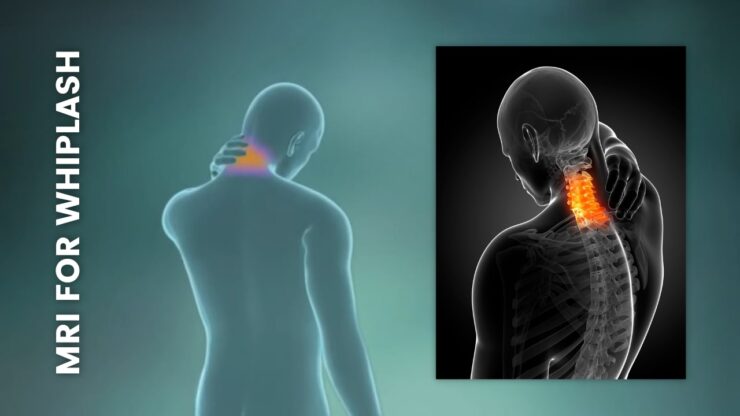Whiplash is a common injury that occurs when the neck is suddenly and forcefully jerked back and forth. It can result from car accidents, sports injuries, and other types of trauma.
Many people who suffer from whiplash wonder whether it will show up on an MRI, which is a medical imaging technique that uses a strong magnetic field and radio waves to create detailed images of the body’s internal structures. In this topic, we will explore whether whiplash can be detected through an MRI and what other diagnostic tests may be used to diagnose this type of injury.
We will also discuss the symptoms of whiplash and the potential treatments that may be recommended for this condition.
Symptoms of whiplash
Whiplash can cause a range of symptoms that can be both physical and psychological.
Physical Symptoms: These include pain or stiffness in the neck, shoulders, arms, and/or back; headaches; difficulty swallowing; numbness or tingling in the arms; ringing noises in the ears (tinnitus) and dizziness. Some people experience jaw pain or shoulder “catching” as well.
Psychological Symptoms: While not universally reported, some people may experience changes in mood, concentration difficulties, trouble sleeping, fatigue, and other cognitive difficulties following whiplash injury.
It is important to seek medical attention if you have suffered any type of neck trauma as this can help determine whether whiplash has occurred. An examination by a healthcare professional is one of the best ways to identify if symptoms such as those mentioned above exist due to whiplash or another type of injury including concussion or spinal cord damage.
In some cases, certain imaging tests such as X-rays or MRI scans may be used to help diagnose whiplash injuries. However, most doctors will use other methods such as clinical exam findings first before recommending further testing.
Diagnosing Whiplash

Diagnosing whiplash can be challenging, and the first step is to understand what types of tests are needed to diagnose it.
One way to diagnose it is to do an MRI, which is a type of imaging scan. Let’s explore what an MRI can reveal about whiplash and how it can help with diagnosis.
Physical examination
Physical examination is a common method that is used to diagnose whiplash. A physical exam can include the assessment of the patient’s range of motion, reflexes, palpation of affected soft tissue structures, and special tests to further assess any autonomic dysfunction.
Range of motion can be tested throughout the entire cervical spine to give an indication of how whiplash may have affected certain areas and what type of treatment plan may be needed. Reflexes should be compared bilaterally as well, as they can provide an indication of neurologic function and any possible injury to a nerve root or peripheral nerve.
Palpation is best done in both relaxed-state and flexion-state movement postures because this can detect a decreased range of motion associated with protective muscle guarding. Special tests are also sometimes used to further examine for autonomic dysfunction or possible nerve root or peripheral nerve injury.
Other commonly used physical examinations include imaging studies such as MRI or CT scans and electrodiagnostic studies like electromyography (EMG) or nerve conduction velocity (NCV). If further examination is needed beyond the physical exams described above, it is important that your medical professional formulate an individualized treatment plan based on your individual case.
Imaging tests
When diagnosing whiplash, imaging tests such as X-rays and MRIs may be used to check for any damage to the bones, joints, disks, or soft tissues in the neck. While X-rays are commonly used to detect fractures and dislocations, they are not able to detect the type of soft tissue damage that is often caused by whiplash injuries. An MRI scan may be ordered if more information is needed about any muscle strain or ligament injury associated with whiplash.
MRIs use powerful magnets and radio waves to create images of the internal organs and tissues in your body. When looking at a patient with suspected whiplash injury, an MRI can help identify disc herniation, nerve root compression, ligament tears, and other soft tissue damage that could not be seen on an X-ray.
This information can then be used by your doctor to determine the best treatment plan for you. Lastly, it should be noted that MRIs alone will not diagnose whiplash; other factors such as clinical presentation and physical examination must also be taken into account before making a diagnosis.
MRI for Whiplash

Magnetic Resonance Imaging, or MRI, is a type of imaging that is used to diagnose a variety of medical illnesses and injuries.
For those who have suffered whiplash, the question arises whether or not an MRI can be helpful in diagnosing it. In this article, we will explore the use of MRI for whiplash and whether or not this type of imaging can provide useful information for diagnosing and treating this condition.
Advantages of MRI
Magnetic Resonance Imaging (MRI) scans are non-invasive procedures that use a magnetic field and radio waves to create detailed images of internal organs and structures. In the case of whiplash, an MRI can be used to assess areas such as the muscles, ligaments, tendons, disks, and nerves for injury or inflammation.
Compared to X-rays or CAT scans, MRIs are generally considered to produce higher-quality images with greater detail. As a result, they may reveal injuries that would be undetected by other imaging methods. Additionally, an MRI is safe for patients as it does not involve exposure to radiation. Because these scans are so detailed and accurate in diagnosing soft-tissue injuries such as whiplash, they can play an important role in determining the extent of damage and formulating a treatment plan:
- For example, MRI scans can detect herniated discs or other degenerative changes more accurately than X-rays or CAT scans.
- MRIs can also identify areas of decreased nerve activity—a sign of nerve irritation or compression—which aid in source identification and treatment.
- In terms of sprains or strains caused by whiplash, MRIs may reveal swelling or bleeding within tendons and ligaments not seen on other forms of imaging.
Thus, an MRI can provide information that helps medical professionals make an accurate diagnosis of whiplash injury and recommend appropriate treatment options – ultimately leading to faster recovery times for their patients.
Limitations of MRI
It is important to understand that MRI scans have both advantages and disadvantages for whiplash diagnosis. While it can provide detailed images of the anatomy, there are several limitations that must be taken into consideration when attempting to diagnose whiplash.
One limitation is that the images do not reveal damage due to trauma or tissue changes caused by inflammation. As such, it is common that no signs or abnormalities appear on an MRI scan in a person experiencing whiplash symptoms. Furthermore, the spinal cord and surrounding structures are also not visible on an MRI scan, which eliminates possible damage caused by trauma and inflammation.
Another limitation is its resolution. Due to the limited resolution of a standard spine-focused MRI, smaller anatomical structures can often go undetected on the scan. In addition, a three-dimensional view of the soft tissues may be difficult to obtain due to their small size in relation to the tissue structure visible in an MRI scan. Small soft tissues such as ligaments may also slip through gaps between slices in an MR image rendering them invisible in some cases despite their presence at a particular level of spine segmental injury or abnormality.
Finally, it should be noted that although a single MRI image can show areas where potentially painful nerve roots exit from their respective vertebral levels; it cannot separate these imaging findings from one another nor whose nerve roots are affected by other pathologies such as disc herniation or ligament injury-related pathology causing pain.
Treatment for Whiplash

Whiplash is an injury to the musculoskeletal system of the neck caused by an abrupt back-and-forth movement of the head. It can be caused by a car accident, a sports-related injury, or any other kind of sudden impact.
Treatment for whiplash may include physiotherapy, massage, or other treatments. If a more serious injury is suspected, an MRI may be recommended.
In this section, we will take a look at the treatment options for whiplash.
Non-surgical treatments
Whiplash is a condition caused by a sudden movement of the head in one direction followed quickly by a motion back in the opposite direction. This typically occurs when an individual is involved in a car accident or another type of traumatic event and can lead to debilitating pain and decreased mobility. Fortunately, there are several treatments available that can help reduce and even eliminate the pain associated with whiplash.
Non-surgical treatments for whiplash include medications such as analgesics and anti-inflammatories, physical therapy, massage therapy, and chiropractic care. When combined together, these treatments have been found to be very effective in controlling pain, increasing mobility, reducing inflammation, and improving the overall quality of life. In addition to medical management options, other supportive therapies such as biofeedback or cognitive behavioral therapy may also be recommended to help address anxiety or depression related to the diagnosis.
If you have been diagnosed with whiplash after an injury or traumatic event, it’s important to talk with your healthcare provider about which treatment option is right for you. Your healthcare provider will recommend a tailored treatment plan that combines medications with physical activity and other supportive strategies that are most likely to help reduce your symptoms. Additionally, if more advanced imaging is necessary, an MRI may be ordered which can provide valuable insight into the severity of the injury and any potential underlying health issues not related directly to the whiplash such as fractures or disk problems.
Surgical treatments
Surgical treatment for whiplash is usually recommended where symptoms persist and have not responded to more conservative management strategies. Surgical interventions may range from the fusion of cervical vertebrae to repairing nerve and ligament damage to vertebrae, or discectomy (removal of a damaged intervertebral disc). Surgery is typically reserved for patients whose pain persists after a course of conservative treatments such as physiotherapy, activity modification, medication, and/or injections.
It’s important to note that the effectiveness and long-term outcome of surgical treatments vary considerably from patient to patient depending on the severity of the initial injury, the age of the patients, their general health, and other factors. Prior to making any decisions around surgical intervention, it’s highly recommended that you consult with a doctor who can assess your pain levels and help create an individualized plan for rehabilitation.
FAQs
How long does it take to recover from whiplash?
The recovery time varies depending on the severity of the injury and the individual’s overall health. Some people may recover within a few weeks, while others may require months of treatment.
Can whiplash cause long-term complications?
In some cases, it can lead to long-term complications such as chronic pain, limited range of motion, and depression.
Can whiplash be prevented?
It can be prevented by wearing seat belts and following proper safety protocols in sports and other activities.
Who is at risk for whiplash?
Anyone can develop it, but it is most commonly associated with car accidents, sports injuries, and other types of trauma.
Is whiplash a serious injury?
It can be a serious injury, but the severity of the injury varies from person to person. In some cases, it can lead to long-term complications and chronic pain.
Should I see a doctor if I think I have whiplash?
Yes, it is important to see a doctor if you think you have it. A doctor can diagnose the injury and recommend the appropriate treatment.
Can I continue to work or engage in physical activity if I have whiplash?
It depends on the severity of the injury and the individual’s symptoms. In some cases, it may be necessary to take time off from work or limit physical activity to allow for proper healing.
Conclusion
In conclusion, whiplash can be difficult to diagnose due to its often invisible symptoms. To properly assess the extent of the whiplash injury, doctors rely on X-rays, CT scans, and MRIs. An MRI will definitely show any soft tissue damage in the neck, such as bruising or swelling. However, it may not detect other types of injury that can cause whiplash symptoms.
Treatment for whiplash usually consists of physical therapy and pain medications. Other treatments may include immobilization with a collar or surgery if there is significant nerve root irritation or cord compression at the cervical spine level.
It is important to follow up with your doctor if your symptoms persist or worsen over time to ensure that you are getting the best possible treatment for your particular situation.

